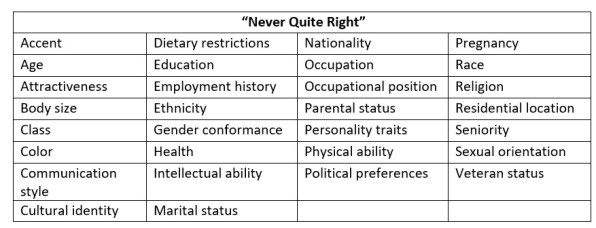A recent study of the 33 biggest multilateral institutions found that of 382 leaders in their history only 47 have been women. And the percentage of women running Fortune 500 companies has only just recently crested a meager 10%.
Women are criticized so often and on so many things that they are acculturated to receiving such disparagement, taking it seriously, and working to make improvements. And any individual woman may take it personally, believing the criticism directed at her to be warranted.
But our research reveals that the problem lies elsewhere. Virtually any characteristic can be leveraged against a woman in a discriminatory fashion. Such criticisms often relate to facets of women’s identity in an overt or subtle way, such as race, age, parental status, attractiveness, and physical ability.
More specifically, our research revealed 30 different characteristics and qualities of a woman’s identity that emerged as points of criticism creating barriers to women’s success. The clear message to women is that—whatever they are—they are “never quite right.”

Age was a consistent challenge for women leaders in our study. Some of our respondents reported being considered too young to lead, while others indicated being too old hindered them from advancing.
Parental status—having children or being childless—emerged as another point of criticism. A higher-education leader described how people assume she “can’t take on a bigger role ‘because of the kids,’” which made her feel that she needed “to work extra hard” to show that she could be both a dedicated mother and a leader.
On the other hand, a childless physician was expected to “work harder/more, accomplish more” than other female colleagues. Mothers were also bypassed for career opportunities, as happened to a single divorced lawyer who was the mother of preschoolers, “due to a perception by my male bosses that I cannot or should not handle [larger matters].”
“Once you are pregnant or trying to have kids, the way management views you deteriorates. The opposite thing happens for male coworkers. I’ve seen it in so many law firms it’s impossible to argue it was just coincidence or based on merit.”
Simply planning on having kids was enough to invoke bias. A woman in higher education reported being denied promotion because she would need maternity leave for hypothetical future children.
Women of color were targets of subtle bias. An African American faith-based leader described being “invisible” and regularly “talked over” by white men. A Native American higher-education executive described being misperceived as weak, “when in fact we are practicing ‘respect’ for ourselves and others.” And a Filipina physician described facing role incredulity, as people assumed that she was “a nurse, and not a doctor and a division chief at that.”
Regarding health, there were double standards around the way men and women with illnesses were treated. A physician developed ovarian cancer while serving as an officer in the public health service. She explained, “The plan was to discharge me . . . even though men with prostate cancer didn’t have to go through that.”
The women leaders in our study were considered too young or too old. They were too short or too tall, too pretty or too unattractive or too heavy. They had too much education or not enough or their degrees were not from the “right” schools. They suffered from disrespect and misperceptions due to race, color, or ethnicity. Whether they had children or were childless, the women were expected to work harder than men to prove their worth. Women were held back from leadership opportunities due to being single, married, or divorced. There was no personality trait sweet spot, as introverted women were not seen as leaders and extraverted women were viewed as aggressive. The effect, then, means women leaders are “never quite right.”
“FLIP IT TO TEST IT”
Leaders can be particularly effective in thwarting sexist criticisms toward women. It’s not about changing the behavior of women—who are the recipients of the unfair treatment—but it is about changing the behaviors of those who justify their actions as somehow merited. Many criticisms fail the “flip it to test it” method miserably. Ask yourself, would the following statements ever be said about a man?
- He needs to smile more.
- Men are going to have kids and not want to work.
- Since Larry has prostate cancer, he can no longer fulfill his job duties.
The clear answer is no. Leaders can infuse awareness of this simple, yet effective, tool to reduce such bias-laden criticisms. And workplace allies can help stop unfair criticism of women by calling it out.
Women are almost one and a half times more likely to receive negative feedback that is subjective rather than constructive and objective feedback. Men are often given a clearer idea of where they excel and opportunities for improvement whereas women are given vague feedback that often focuses on qualities like communication style. Even when using formal performance evaluation rubrics, a disparity remains.
Developmental feedback to women focuses on operational tasks, coping with politics, developing resilience, being cooperative, and building confidence. Developmental feedback to men focuses on setting a vision, leveraging power and politics, being assertive, and displaying confidence. Leaders can reduce the gender-biased framing by encouraging all employees to develop both sets of skills.
DO NOT TAKE IT PERSONALLY
For individual women, hear us when we say, “It’s not you.” We women are conditioned to accept feedback and internalize it as something to “fix” about ourselves. If you are criticized, consider whether it is objective, constructive, and warranted. Disregard identity-based criticisms that are part of a larger pattern of bias against women.
If you are experiencing discrimination at your place of employment, contact the Law Offices of Renee Lazar at 978-844-4095 to schedule a FREE case evaluation.
fastcompany.com